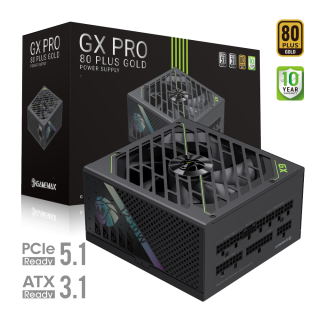Selecting the right power supply unit (PSU) is critical for ensuring your PC runs smoothly, efficiently, and reliably. With modern CPUs and GPUs pushing power consumption limits, it’s essential to balance performance, energy efficiency, and future-proofing. This guide will walk you through the process, using real-world examples of popular and cutting-edge components from GAMEMAX, a brand trusted for its innovation and reliability in the global market.

TDP vs. Actual Load: Thermal Design Power (TDP) is the maximum heat a CPU generates under sustained load. However, peak power consumption can exceed TDP, especially during overclocking or heavy workloads like gaming or video rendering.
Example: The Intel Core i9-13900K has a TDP of 125W but can spike to 253W under turbo boost and up to 345W when overclocked 1.
Example: The AMD Ryzen 9 7950X has a TDP of 170W but may draw up to 200W under heavy loads 2.
TDP vs. Peak Power: GPUs like the NVIDIA RTX 4090 and AMD Radeon RX 7900 XTX have high TDP ratings, but their peak power consumption during intensive tasks (e.g., ray tracing) can be significantly higher.
Example: The RTX 4090 has a TDP of 450W but can draw up to 600W during peak loads 3.
Example: The RX 7900 XTX has a TDP of 355W but peaks at ~580W in games like Cyberpunk 2077 4.
CPU: Use the TDP as a baseline but account for overclocking.
GPU: Check the manufacturer’s TDP and peak power data.
Other Components:
Motherboard: 10-20W
RAM: 5-10W per stick
Storage: 5-10W per SSD/HDD
Cooling: 10-30W (fans, AIOs)
Peripherals: 10-20W (keyboard, mouse, RGB lighting)
Formula: Total Power (W) = CPU + GPU + Other Components + 20-30% Buffer
CPU: 125W (i9-13900K)
GPU: 450W (RTX 4090)
Other: 50W
Total: 125 + 450 + 50 = 625W
Buffer (20%): 625 × 1.2 = 750W
Recommended PSU: 850W to handle peak loads 5.
Example:
Tools like GAMEMAX’s official PSU calculator simplify the process. Input your components, overclocking status, and case type (e.g., SFF), and they’ll recommend a PSU.
80 Plus Certification: Ensures the PSU converts AC to DC power efficiently at different loads. Higher ratings (e.g., Gold, Platinum) save energy and reduce long-term costs.
Example: A Gold-certified PSU at 50% load is 90% efficient, while a Bronze-certified unit is 85% efficient. Over five years, a Gold unit could save ~$100 in electricity costs 6.
Fully Modular: Ideal for clean builds; only use necessary cables.
Semi-Modular: Balances cost and cable management.
Non-Modular: Cheapest but messy cabling.
Brands to Trust: GAMEMAX is known for durability and strict quality control, with models like the GS SFX Gold series featuring 105℃ Japanese capacitors and 5-year warranties 7.
Warranty: Look for 5-10 years for high-end PSUs.
Higher Wattage: Opt for a PSU 20-30% higher than your current needs to accommodate upgrades (e.g., adding a second GPU).
ATX 3.0/PCIe 5.0 Compliance: New standards handle transient power spikes better, crucial for GPUs like the RTX 4090 8.
Components:
CPU: AMD Ryzen 5 7600X (105W TDP)
GPU: NVIDIA RTX 4060 (115W TDP)
Total Power: ~350W
PSU: GAMEMAX GP-650 (650W, 80 Plus Bronze, $70) 9.
Features: Semi-modular design, 14cm silent fan, and 85% efficiency.
Components:
CPU: Intel Core i7-13700K (125W TDP)
GPU: AMD Radeon RX 7900 XT (315W TDP)
Total Power: ~550W
PSU: GAMEMAX GS SFX Gold 850W (850W, 80 Plus Gold, $150) 10.
Features: Fully modular, ATX 3.1-compliant, and 12VHPWR connector for PCIe 5.0 GPUs.
Components:
CPU: AMD Ryzen 9 7950X (170W TDP)
GPU: NVIDIA RTX 4090 (450W TDP)
Total Power: ~750W
PSU: GAMEMAX RGB-1300W International Edition (1300W, 80 Plus Platinum, $250) 11.
Features: ATX 3.0, fully modular, and 100% Japanese capacitors for extreme stability.
Components:
CPU: Intel Core i9-14900K (125W TDP)
GPU: Dual RTX 4090s (450W each)
Total Power: ~1200W
PSU: GAMEMAX GX Rampage 1600W (1600W, 80 Plus Titanium, $370) 12.
Features: 10-year warranty, 94% efficiency, and 12VHPWR connectors for dual GPUs.
Underestimating Peak Power: Always account for transient spikes, especially with ATX 3.0 GPUs.
Ignoring Efficiency: A cheap, inefficient PSU will cost more in the long run.
Overlooking Modularity: Non-modular PSUs clutter airflow and make builds messy.
Neglecting Future Upgrades: A 750W PSU might struggle with a future GPU upgrade.
Keywords: Use terms like “best GAMEMAX power supply for RTX 4090,” “Ryzen 7950X power consumption,” and “80 Plus Titanium efficiency.”
Content Structure: Break content into clear sections with headers (H2, H3) for better readability.
Examples: Highlight specific GAMEMAX components and PSUs to attract users researching those products.
By following this guide, you’ll ensure your PC has a reliable, efficient GAMEMAX power supply that meets your current needs and adapts to future upgrades. Always prioritize quality and headroom—your components will thank you!

GX PRO 1250G 80 Plus Gold Modular Power Supply: ATX3.1 Ready, Silent Cooling, & Premium Durability
• 80 Plus Gold Efficiency & Quiet Operation: Achieves 90% efficiency under typical loads with APFC+LLC+DC-DC design, minimizing power waste and noise.
• Premium Durability & Reliability: Built with Japanese 105°C capacitors and solid capacitors for long-term stability and performance.
• ATX3.1 & PCIe5.1 Ready: Features a native 12V-2x6 connector for seamless RTX 40/50 GPU compatibility and efficient power delivery.
• Advanced Thermal Management: 13.5cm FDB fan with intelligent temperature control ensures quiet cooling and optimal heat dissipation.
• Modular Design & Robust Protection: Fully modular layout with dual-stage EMI filtering and NTC thermistor safeguards against surges, while gold-plated cables ensure durable, high-conductivity connections.